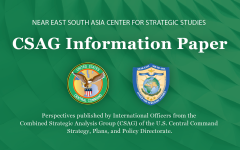Iran and Regional Security
March 18, 2021 2021-03-18 19:57Iran and Regional Security
By NESA Professor Dr. Gawdat Bahgat
18 March 2021
In November 2020, only days before he was elected President of the United States, then-candidate Joseph Biden stated, “I will offer Tehran a credible path back to diplomacy. If Iran returns to strict compliance with the nuclear deal, the United States would rejoin the agreement as a starting point for follow-on negotiations.” Since he took office on January 20th as the 46th President of the United States, speculation has intensified on the steps each side can take to facilitate the “revival” of the nuclear deal. Ayatollah Khamenei, Iran’s Supreme Leader, called on Washington to take the initiative: “Iran has fulfilled all its obligations under the 2015 nuclear deal/Joint Comprehensive Plan of Action (JCPOA), not the United States and the three European countries (Britain, France and Germany). If they want Iran to return to its commitments, the U.S. must lift all sanctions first.” In response, President Biden said that the United States will not lift sanctions against Iran unless the country stops enriching uranium. Meanwhile, Iranian Foreign Minister Mohammad Zarif suggested that the European Union Foreign Policy Chief, Josep Borrell, “synchronize or choreograph the actions” needed from both sides as a way to overcome the impasse over who goes first in returning to the nuclear deal. These contradictory statements, and the complicated ongoing standoff between Iran and the United States, raise questions on how to move forward on reviving the JCPOA and the implications for regional security.
Certainly, Iran’s nuclear program and stability in the Middle East/West Asia region, and indeed around the world, are a major priority to President Biden. However, the Biden administration clearly must deal with many other priorities – the most important of which is containing COVID-19 and kick-starting an economic recovery. Other important challenges include settling racial tensions, tackling climate change, and strengthening the United States’ strategic position with regard to Russia and China. To further complicate Biden’s foreign policy, many officials from inside and outside the Administration argue that Washington should not rush to lift sanctions, using them instead as leverage to force Tehran to make concessions on its ballistic missile capabilities and regional policy.
On the other hand, the Iranian approach to revive the nuclear deal is drastically different from the American one. When the United States withdrew from the JCPOA in 2018, it continued pressuring Iran, which continued fully observing its commitments. The nation waited for a year after U.S. withdrawal and European hedging before it started gradually rebuilding its nuclear program. Finally, the Iranians feel vindicated, and indeed empowered, by Trump’s electoral defeat. In Tehran, this means the “maximum pressure” policy has failed and the Islamic Republic has survived the brutal sanctions.
The mere survival of the Islamic Republic under the heavy economic, political and military pressure over the last four years is seen as a great achievement in Tehran, but the Iranian regime is not out of the water yet. The survival of any political system depends, to a great extent, on its ability to meet the economic expectations of its people. The Iranian economy has been in a recession for the last three years, was deeply affected by the COVID-19 outbreak, and, according to the World Bank, is projected to grow by 1.5 percent in 2021, much lower than most of its neighbors. The nation simply cannot afford to remain under sanctions for much longer.
Within this context, in December 2020, the Iranian Parliament passed a new law “Strategic Counteractive Plan for Lifting Sanctions and Safeguarding Rights of the Iranian People.” The legislation requires Iran to take significant steps to ratchet up its nuclear activities if certain sanctions relief measures are not met. It requires the Atomic Energy Organization of Iran (AEOI) to cease voluntary implementation of the Additional Protocol to its safeguard agreement if certain sanctions on banking and oil are not lifted. The law requires the AEOI to produce more 20%-enriched uranium and store it inside the country and return the Arak heavy water reactor to its pre-JCPOA condition. The implementation of some of these steps has already started and will continue in the coming weeks and months. It is not clear how the United States and the other signatories to the nuclear deal would react to this Iranian pressure to lift the sanctions. What is certain, however, is that the nuclear program and its potential implications on regional security in the broad Middle East/West Asia must be addressed.
In sum, the decades-long hostility between the United States and Iran has strong impact on the security and stability of all neighboring countries. These states cannot afford to be bystanders. They need to make important decisions to address this multi-dimensional conflict between Washington and Tehran. Should they support one of the two nations? Should they try to mediate and facilitate diplomatic negotiation? And, are they open to re-structuring a new regional security architecture and accept each other’s legitimate security concerns?
The views presented in this article are those of the speaker or author and do not necessarily represent the views of DoD or its components.



